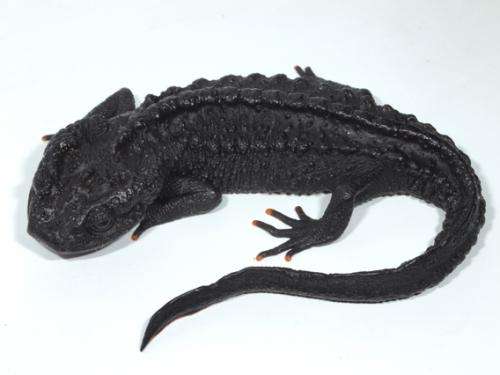March 21, 2013 report
New species of crocodile newt identified in Vietnam

(Phys.org) —A new species of crocodile newt has been identified by a team of Japanese researchers—based on study of a specimen held at Japan's National Museum of Nature and Science in Tokyo and field study in Vietnam. The original specimen, the team writes in their article describing the find in the journal Current Herpetology, was found in the mountainous northern provinces of Vietnam's Ha Giang and Cao Bang.
A newt is a member of the salamander family (Salamandridae)—genus Tylototriton—though, not all salamanders are considered newts—one of their main differentiating characteristics is rougher skin. They are aquatic and have been found to live in North America, Asia and Europe. Crocodile newts are so named due to their similar appearance to crocodiles—they're much smaller of course, generally only stretching to a few inches long.
The new specimen was found at the museum in Japan, and its curator contacted Kanto Nishikawa, one of the researchers involved in the study. Initial observations indicated nothing out of the ordinary, but after closer inspection, the team realized that its morphology didn't conform to any known species. They subsequently performed genetic analysis which confirmed the newt as a new species: Tylototriton ziegleri— Ziegler's crocodile newt—after the prominent German researcher Thomas Ziegler, who has contributed greatly to the study and conservation of amphibians and reptiles in Vietnam.
The newt is deep black all over save for its orange tipped feet—average male length is estimated to be two to two and a half inches long—the females are slightly longer. Its body sports horny crocodile-looking scales along its length and its head resembles that of a horned toad. All told, the newt offers a very striking appearance.
Crocodile newts are prized by collectors and as a result, 3 of the 10 known species are considered endangered or near extinction, including this new discovery. Their range is limited and as humans move in, changing the terrain, their chances of survival are reduced. For this reason, the researchers suggest that the Ziegler's crocodile newt be added to the list of protected species as soon as possible to help it survive.
More information: A New Species of Tylototriton from Northern Vietnam (Amphibia: Urodela: Salamandridae), Current Herpetology 32(1):34-49. 2013 www.bioone.org/doi/abs/10.5358/hsj.32.34
Abstract
A new species of the salamandrid genus Tylototriton is described from Ha Giang and Cao Bang provinces, northern Vietnam, based on molecular and morphological data. The new species differs morphologically from all known congeners in the combination of blackish body coloration; medium-sized body; distinctly rough skin; tubercular vertebral ridge; knob-like rib nodules; large eye; and low, narrow tail. The distribution pattern of species of Tylototriton in Vietnam is briefly discussed.
via Mongabay
© 2013 Phys.org




















